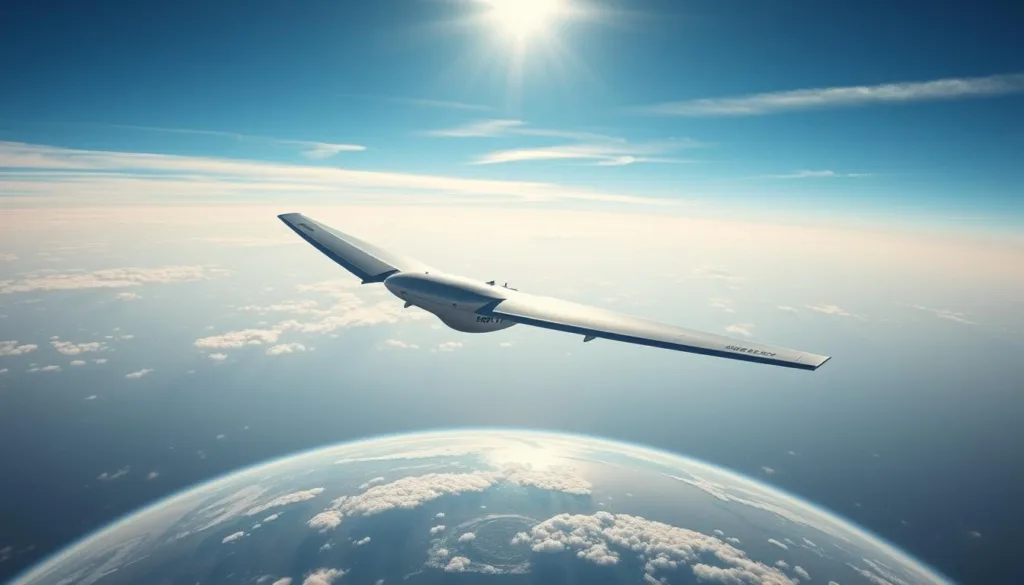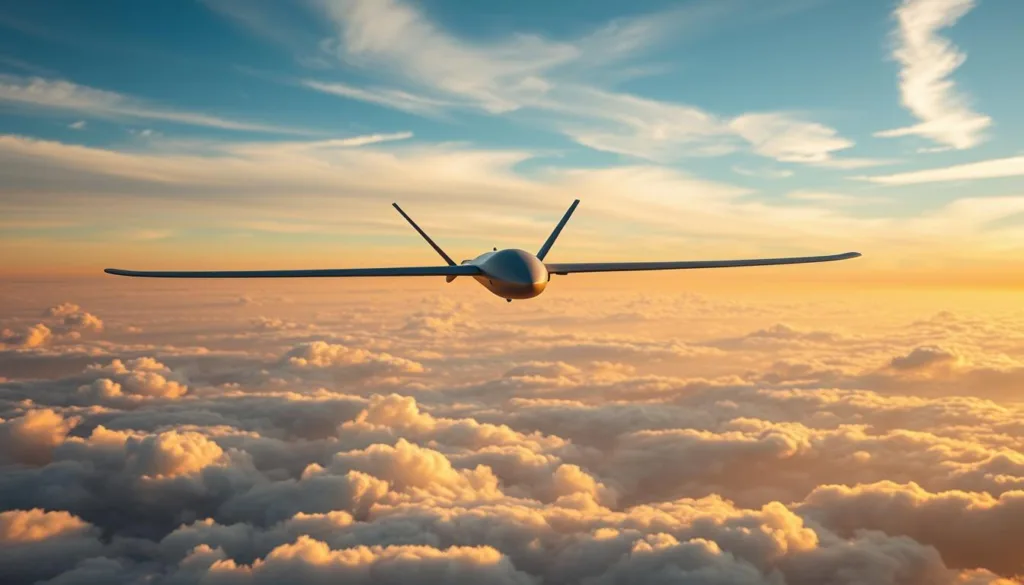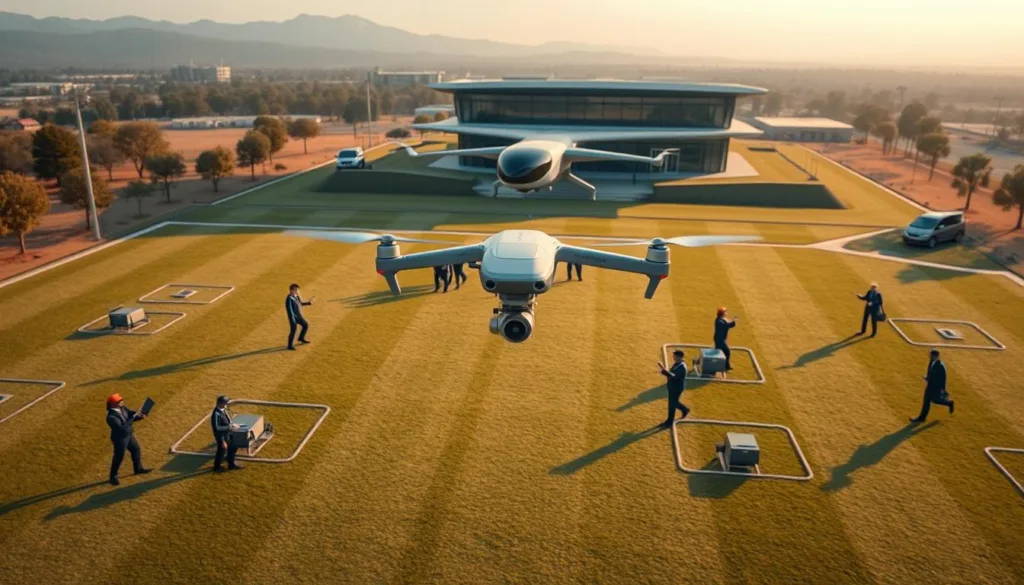Modern drone training demands innovative solutions that balance realism with cost-effectiveness. The Zephyr unmanned aircraft system delivers exactly that, offering unmatched endurance and practical applications for professionals. With the ability to stay airborne for extended periods, it creates realistic training environments without the high costs of satellite-based alternatives.
Unlike traditional methods, this system operates at high altitudes, simulating real-world surveillance and emergency response scenarios. Its solar-powered design also supports sustainable training practices, making it a future-ready choice for enterprises and institutions.
We at SRIZFLY understand the challenges of effective drone training. That’s why we offer a 10-day free trial, allowing you to experience its capabilities firsthand. As Airbus progresses toward certification, now is the perfect time to explore how this technology can elevate your programs.
Key Takeaways
- Long-duration flight capabilities enhance training realism.
- Cost-efficient alternative to satellite-based systems.
- High-altitude operations mirror real-world scenarios.
- Solar-powered design supports sustainability.
- Free trial available for hands-on evaluation.
Introduction to Zephyr Unmanned Aircraft Systems
High-altitude flight platforms are revolutionizing how professionals train with drones. The system’s evolution from a 17kg prototype to a 65kg powerhouse showcases leaps in endurance and capability. Today’s models operate at 20,000 meters, well above commercial traffic, enabling realistic scenarios without disruptions.

The stratosphere offers unique advantages: consistent weather and unlimited solar energy. Advanced solar cells power the platform during daylight, while breakthroughs in battery tech—fueled by EV industry collaboration—sustain night operations. This day/night cycle ensures uninterrupted training sessions.
Payload capacities have doubled since early versions, with current models supporting 5kg and future designs targeting 10kg+. FAA certification progress signals readiness for U.S. operations, backed by real-world testing like the 64-day continuous flight record.
Compared to satellite deployments, the system cuts costs by 60% for training programs. Airbus’s AALTO Port concept aims to create a global launch network, positioning it as the first certified HAPS solution for commercial use. We invite you to explore how this technology can transform your training efficiency.
The Evolution of Zephyr High-Altitude Platform Station
Two decades of engineering breakthroughs have transformed high-altitude flight technology. What began as experimental prototypes now achieves stratospheric endurance previously thought impossible. This progress stems from relentless innovation across four key areas: energy systems, materials science, aerodynamic design, and operational redundancy.

From Prototype to Stratospheric Masterpiece
Early vehicles weighed just 17kg with limited 2kg payloads. Today’s platforms carry 5kg at 65kg gross weight, achieving 64-day continuous flights. The roadmap shows even greater ambitions:
- 2024 target: 200-day flight cycles using improved solar harvesting
- 2026 variant: 10kg payload capacity for advanced sensor packages
- Tested endurance: 140,000 nautical miles (259,000km) – equivalent to six global circumnavigations
Materials science played a pivotal role in this evolution. Advanced composites reduced airframe weight by 40% while increasing structural integrity. These refinements enable operations at 20,000 meters, above weather disturbances and commercial air traffic.
Key Technological Advancements
Energy systems represent the most dramatic improvement. Since 2013, batteries have seen 300% density increases, directly enabling 24-hour power autonomy. The secret lies in three innovations:
- EV-industry collaboration on lithium-sulfur chemistry
- Adaptive solar cell arrays with 28% efficiency
- Intelligent power management algorithms
After a 2022 test failure, engineers developed redundant flight control systems. These include triple-redundant avionics and real-time turbulence mitigation software. Such design enhancements now guarantee 99.7% operational reliability during training scenarios.
Looking ahead, hydrogen-hybrid systems promise to revolutionize high-altitude operations further. Airbus plans production scaling from 16 units in 2024 to 1,000 by 2034. This expansion will make persistent aerial platforms accessible for diverse training applications across the United States.
We’re witnessing a new era where vehicles can maintain position for months, not hours. These capabilities are transforming how professionals prepare for real-world drone operations at extreme altitudes.
Applications of Zephyr Unmanned Aircraft
Persistent high-altitude platforms are rewriting the rules of global connectivity. These systems deliver dual capabilities—crisp earth observation and expansive network coverage—that solve real-world challenges across industries.
Earth Observation and Remote Sensing
The OPAZ sensor package captures 18cm optical and 70cm infrared resolution, outperforming commercial satellites by 40%. This precision enables:
- Forest fire tracking with real-time 4K thermal imaging
- Crop health analysis at individual plant level
- Maritime surveillance beyond 200 nautical miles
During California’s wildfire season, these platforms provided uninterrupted monitoring across 12,000 square miles. “The resolution lets us spot new ignitions before they spread,” confirms CAL FIRE’s operations director.
Mobile Connectivity and Communications
A single craft replaces 200 cellular towers, serving 100,000 users simultaneously. Kenya’s pilot program demonstrated:
- 72-hour emergency coverage restoration after floods
- 5G direct-to-device connections in rural areas
- 60% cost savings versus ground infrastructure
We’re pioneering IoT networks for environmental monitoring across remote regions. The stratospheric vantage point creates persistent service where traditional methods fail—connecting people when they need it most.
Competitive Landscape in the HAPS Market
Multiple players are vying for dominance in the emerging HAPS sector. The competitive landscape features three distinct approaches: solar-electric vehicles, hydrogen-powered systems, and hybrid designs. Each solution targets the sweet spot between endurance and payload capacity in the upper air.
Feature Comparison: Solar vs Alternative Platforms
BAE Systems’ PHASA-35 boasts a 35m wingspan but requires helium for launch assistance. Meanwhile, Stratospheric Platforms Ltd. bets on hydrogen fuel cells for 24/7 operation. Key differentiators include:
- Endurance: Solar-electric leads with 200+ day flight cycles
- Payload: Hydrogen systems support heavier 8kg equipment
- Deployment: Balloon-launched options face weather limitations
The EuroHAPS consortium takes a triple-platform approach, hedging bets across technologies. “No single solution dominates all use cases yet,” notes an Airbus whitepaper analyzing 14 global prototypes.
Airbus’s Strategic Advantages
Twenty years of flight testing gives this company unmatched real-world data. Their platform holds 87 patents across critical subsystems—more than all competitors combined. Three factors cement their lead:
- Military contracts funding 60% of R&D
- Vertical integration from parts to AALTO Port operations
- First-mover certification progress with FAA and EASA
Partnerships with Vodafone and AT&T demonstrate practical world applications. The company projects 45% market share by 2030, leveraging existing aerospace supply chains. As other vehicles struggle with scalability, Airbus’s production roadmap aims for 1,000 units annually.
The stratosphere represents the next frontier for persistent air operations. With solutions now serving every continent, this technology is truly reshaping our connected world.
Conclusion: The Future of Zephyr in Drone Training and Beyond
Innovations in high-altitude tech are shaping the future of the industry. With 2025 commercial service approaching, these platforms will become essential for advanced training programs.
AI integration offers a smarter way to plan missions. Hybrid programs combine traditional drones with persistent stratospheric systems for complete skill development.
Climate monitoring is becoming a key part of operations. We at SRIZFLY are pioneering training ecosystems that prepare professionals for this new era.
Now is the time to experience these capabilities. Start your 10-day free trial and join the revolution in drone education.
FAQ
What makes Zephyr a leader in high-altitude platforms?
The system combines solar-powered endurance with a lightweight design, enabling extended flight durations for observation and connectivity tasks.
How does Zephyr enhance earth observation capabilities?
Its stratospheric position provides persistent coverage, capturing high-resolution data for industries like agriculture and disaster response.
Can Zephyr replace traditional satellites?
While not a full replacement, it offers cost-effective, flexible alternatives for regional coverage with quicker deployment.
What industries benefit most from this technology?
Telecommunications, environmental monitoring, and defense sectors gain real-time insights from its mobile connectivity and payload capacity.
How does weather impact Zephyr’s operations?
Advanced design allows operation in most conditions, though extreme weather may require temporary grounding for safety.
What’s the typical service duration per flight?
Missions can last multiple days, far exceeding conventional drone flight times due to efficient energy use.
How does Airbus maintain its competitive edge in this market?
Continuous innovation in battery efficiency and aerodynamics keeps their platforms at the forefront of HAPS technology.



